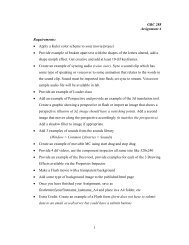Introducing Financial Accounting - CCSN Computer Graphics Program
Introducing Financial Accounting - CCSN Computer Graphics Program
Introducing Financial Accounting - CCSN Computer Graphics Program
Create successful ePaper yourself
Turn your PDF publications into a flip-book with our unique Google optimized e-Paper software.
wiL27041_ch01_002-047.indd Page 5 10/4/10 7:12:10 PM user-f499 /Volumes/204/MHBR211/wiL27041_disk1of1/0073527041/wiL27041_pagefiles<br />
Chapter 1 <strong>Introducing</strong> <strong>Financial</strong> <strong>Accounting</strong> 5<br />
Technology is a key part of modern business and plays a major role in accounting. Technology<br />
reduces the time, effort, and cost of recordkeeping while improving clerical accuracy. Some<br />
small organizations continue to perform various accounting tasks manually, but even they are<br />
impacted by technology. As technology has changed the way we store, process, and summarize<br />
masses of data, accounting has been freed to expand. Consulting, planning, and other financial<br />
services are now closely linked to accounting. These services require sorting through data, interpreting<br />
their meaning, identifying key factors, and analyzing their implications.<br />
Users of <strong>Accounting</strong> Information<br />
<strong>Accounting</strong> is often called the language of business because all organizations set up an accounting<br />
information system to communicate data to help people make better decisions. Exhibit 1.2 shows<br />
that the accounting information system serves many kinds of users (this is a partial listing) who<br />
can be divided into two groups: external users and internal users.<br />
A<br />
A<br />
A<br />
A<br />
A<br />
A<br />
A<br />
A<br />
A<br />
A<br />
A<br />
A<br />
A<br />
000027<br />
000028<br />
000029<br />
000030<br />
000031<br />
000032<br />
000033<br />
000034<br />
000035<br />
000036<br />
000037<br />
000038<br />
000039<br />
521<br />
789<br />
506<br />
505<br />
567<br />
152<br />
726<br />
-----<br />
359<br />
657<br />
254<br />
658<br />
236<br />
• Lenders<br />
• Shareholders<br />
• Governments<br />
–012<br />
003<br />
–006<br />
–009<br />
–013<br />
003<br />
–001<br />
------<br />
–003<br />
008<br />
–003<br />
–003<br />
–003<br />
521<br />
789<br />
506<br />
505<br />
567<br />
152<br />
726<br />
-----<br />
359<br />
657<br />
254<br />
658<br />
236<br />
521<br />
789<br />
506<br />
505<br />
567<br />
152<br />
726<br />
-----<br />
359<br />
657<br />
254<br />
658<br />
236<br />
521<br />
789<br />
506<br />
505<br />
567<br />
152<br />
726<br />
0<br />
359<br />
657<br />
254<br />
658<br />
236<br />
521<br />
789<br />
506<br />
505<br />
567<br />
152<br />
726<br />
-----<br />
359<br />
657<br />
254<br />
658<br />
236<br />
• Consumer groups<br />
• External auditors<br />
• Customers<br />
• Officers<br />
• Managers<br />
• Internal auditors<br />
• Sales staff<br />
• Budget officers<br />
• Controllers<br />
External Information Users External users of accounting information are not directly<br />
involved in running the organization. They include shareholders (investors), lenders, directors,<br />
customers, suppliers, regulators, lawyers, brokers, and the press. External users have limited<br />
access to an organization’s information. Yet their business decisions depend on information that<br />
is reliable, relevant, and comparable.<br />
<strong>Financial</strong> accounting is the area of accounting aimed at serving external users by providing<br />
them with general-purpose financial statements. The term general-purpose refers to the broad<br />
range of purposes for which external users rely on these statements.<br />
Each external user has special information needs depending on the types of decisions to be<br />
made. Lenders (creditors) loan money or other resources to an organization. Banks, savings and<br />
loans, co-ops, and mortgage and finance companies are lenders. Lenders look for information to<br />
help them assess whether an organization is likely to repay its loans with interest. Shareholders<br />
(investors) are the owners of a corporation. They use accounting reports in deciding whether to<br />
buy, hold, or sell stock. Shareholders typically elect a board of directors to oversee their interests<br />
in an organization. Since directors are responsible to shareholders, their information needs<br />
are similar. External (independent) auditors examine finan cial statements to verify that they are<br />
prepared according to generally accepted accounting principles. Nonexecutive employees and<br />
labor unions use financial statements to judge the fairness of wages, assess job prospects, and<br />
bargain for better wages. Regulators often have legal authority over certain activities of organizations.<br />
For example, the Internal Revenue Service (IRS) and other tax authorities require organizations<br />
to file accounting reports in computing taxes. Other regulators include utility boards<br />
that use accounting information to set utility rates and securities regulators that require reports<br />
for companies that sell their stock to the public.<br />
<strong>Accounting</strong> serves the needs of many other external users. Voters, legislators, and government<br />
officials use accounting information to monitor and evaluate government receipts and<br />
expenses. Contributors to nonprofit organizations use accounting information to evaluate the<br />
use and impact of their donations. Suppliers use accounting information to judge the soundness<br />
Point: Technology is only as useful<br />
as the accounting data available, and<br />
users’ decisions are only as good as<br />
their understanding of accounting.<br />
The best software and recordkeeping<br />
cannot make up for lack of<br />
accounting knowledge.<br />
Margin notes further enhance<br />
the textual material.<br />
EXHIBIT 1.2<br />
Users of <strong>Accounting</strong> Information<br />
Infographics reinforce key<br />
concepts through visual learning.<br />
C2<br />
Identify users and uses<br />
of, and opportunities in,<br />
accounting.









